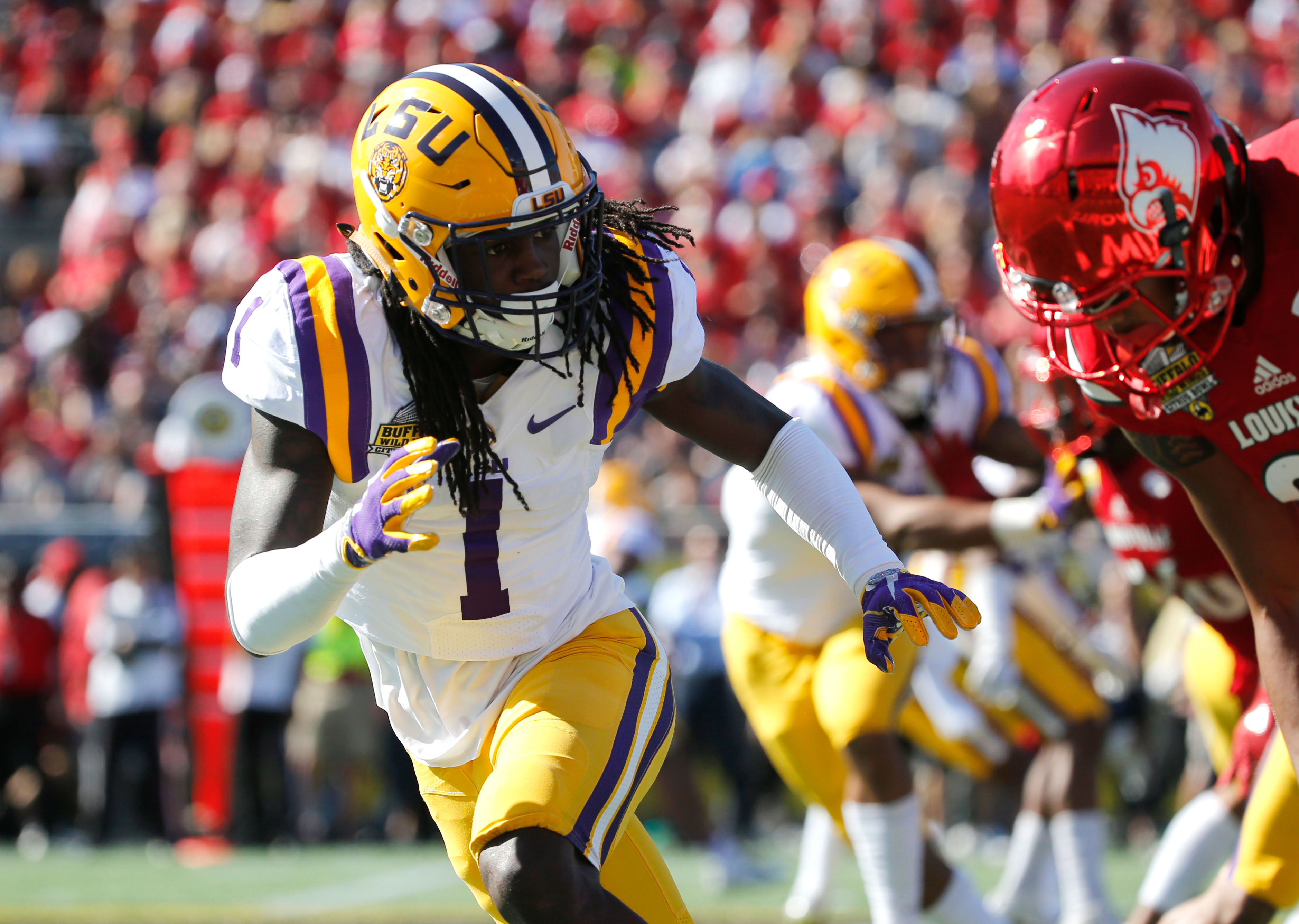
Can comfort with, and further implementation of, coordinator Dave Aranda’s scheme improve LSU’s pass defense despite major player losses?
It won’t be easy, because last year’s numbers were pretty darn good. The Tigers held their opponents to 197.2 passing yards per game, ranking third in the SEC. Overall, the defense allowed 16 touchdowns in 2016, the fewest in the nation.
On the other hand, LSU didn’t intercept many passes in Aranda’s debut season in Baton Rouge, leaving room for improvement if players can ably replace departed stars.
Gone from the secondary are first-team All-America defensive back Tre’Davious White and first-team All-SEC safety Jamal Adams. Seasoned veterans in DB Kevin Toliver II, DB Donte Jackson and safety John Battle return to carry on the tradition of excellent coverage.
Duke Riley and Kendell Beckwith’s graduation leaves the linebacking corps in the hands of senior Donnie Alexander and sophomore Devin White, who will aim to help the Tigers’ loaded linebacker freshman class adjust to the college game.
Passing yards allowed per game (SEC rank): 197.2 (3)
Sacks: 28 (4)
Interceptions: 9 (12)
Sack artist
As a former defensive line coach, LSU coach Ed Orgeron appreciates top pass rushers, and there’s no doubt he has one of the best in the country returning to Baton Rouge this season in junior Arden Key.
After missing spring drills for “personal reasons,” Key returned to the program and began practicing with the team in early June.
The Atlanta native has been a menace to quarterbacks since his freshman season, but he took chasing down signal-callers to another level in 2016, tallying an LSU single-season record 12 sacks and 11 quarterback hurries.
Key’s 6-foot-6, 238-pound frame combined with his excellent quickness off the snap enables him to disrupt even the calmest of quarterbacks, like this sack for a safety on 2016 Heisman Trophy winner Lamar Jackson during the Buffalo Wild Wings Bowl.
Best cover linebacker
With seasoned veterans Beckwith and Riley off to the NFL, the Tigers lack a go-to linebacker in coverage.
From the same Tigers’ tradition that produced Ali Highsmith, Kelvin Sheppard and Kevin Minter enter the next-in-line of LSU’s emotional leaders, Alexander and White.
Despite playing behind Beckwith and Riley, Alexander has shown glimpses of great instincts in coverage, grabbing an easy pick against Arkansas last season. The New Orleans native tallied 45 tackles, two quarterback hurries and two passes defended in 2016.
Along with Alexander, former running back Devin White has stepped into a leadership role as a sophomore. White emerged as a playmaker in his debut season as a Tiger, notching 30 tackles, a sack, a forced fumble and a fumble recovery.
Behind White and Alexander lies a host of freshmen – K’Lavon Chaisson, Jacob Phillips, Patrick Queen and Tyler Taylor, all of whom come to Baton Rouge rated as 4-star recruits by 247 Sports.
The interior linebackers’ transition might be helped along by the fact that Aranda is their position coach.
Best shutdown corner
Despite losing one of the best cover corners in the country in White, LSU returns two veteran starters – juniors Jackson and Toliver – keen to earn the title of the Tigers’ top cover man.
Jackson emerged as the starter opposite White in 2016, tallying 8 pass break-ups, 2 interceptions and 39 tackles in 11 starts.
Toliver — limited by injuries last season — burst on the scene during his freshman campaign in 2015, notching 35 tackles and 6 passes defended in eight starts to earn True Freshman All-America honors from 247Sports.com.
Toliver and Jackson’s proven success against top wideouts gives Aranda flexibility.
Jackson’s immense speed — on the track, his personal best indoor 60-meter time is 6.63 seconds — translates well to the gridiron, allowing him to keep pace with any receiver. He blossomed with improved technique last season.
While Jackson relies on speed, Toliver uses every inch of his 6-foot-2, 193-pound frame to match up against physical wideouts, particularly in man-to-man coverage.
Behind Jackson and Toliver, competition fuels the development of the rest of the relatively unknown secondary.
The stat that must improve
Despite their success at limiting opponents’ passing attacks overall last season, the Tigers struggled to create turnovers, ranking 12th in the SEC (and 81st in the NCAA) with nine interceptions.
Historically, LSU’s defense has thrived with an elite ball-hawking secondary. In its past two national championship seasons, LSU averaged 22 interceptions. Aranda’s defenses at Wisconsin, however, averaged only nine in his three seasons there.
It will be interesting to see if this lack of picks is simply characteristic of the way Aranda’s system functions, or if the Tigers’ depth in the secondary can change the trend.
Secondary scheme
Aranda kept his defense relatively simple during his first year at LSU, but this season will feature many changes as he and the Tigers dive deeper into professor Aranda’s playbook.
With the addition of more nuances in schemes and coverages, Aranda will be able to showcase the versatility of his players and make his defense harder to predict.
With Adams off the NFL, both Battle and presumed senior starter Ed Paris will play close to the line at times and deep at times, giving Aranda flexibility to disguise coverages.
Freshmen safeties Grant Delpit and JaCoby Stevens should be ready to contribute after both enrolled early and participated in spring practice.
Although the Tigers lost two first-round NFL draft picks from the secondary, the Tigers’ depth at defensive back still begs for Aranda to use variations of the nickel to put as many ball-hawking players in coverage as possible.
Better or worse
Despite the loss of top talent, the Tigers passing defense will be stronger as Aranda settles into his second season and more of his recruits enter Baton Rouge better suited to star in his 3-4 defense.







